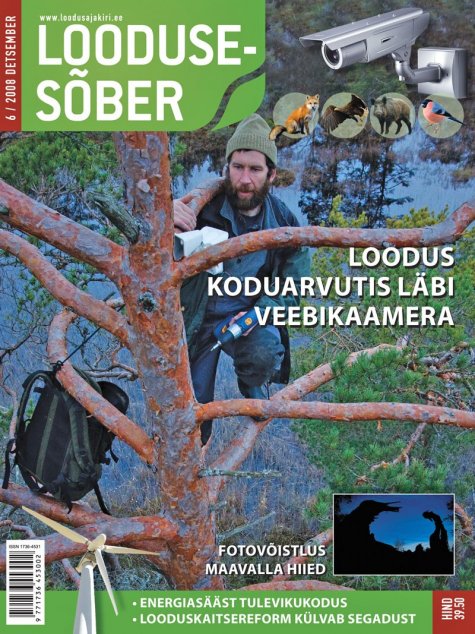Tiit Randla: Ravens Guide The White-Tailed Eagles
Tiit Randla in the eagle woods.
In the December issue of Loodusesõber, Eagleman Tiit Randla tells us how he caters for the star actors of Eagle Camera.
Do people get any grasp of the winter life of eagles from the camera pictures?
Yes. Eagles flock together in winter otherwise too, on the coast by the sea. There is food: drowned wild boars, long-tail ducks, goldeneyes etc. When a hunter shoots an elk, and there is something left behind, the ravens will be there at once. And they mark the site for the white-tailed eagles.
For how long do the eagles collect in feeding places, until Spring?
Once we went to the bog, it was really beautiful March weather, the snow was all glistening. We saw many white-tailed eagles, a couple here, another there. We got curious about why they were sitting there, and started to look around. And found slain deers. They were picked so clean that only bones were left. This had been important food for the eagles, so even in the the spring they still came there in numbers. In March they are really already looking for nesting places.
What does the eagle do on the perching tree, why are they sitting there?
He has a full stomach, but – this is what I think – he still takes some culinary interest in the surroundings. He notices things, he observes. If he gets very jealous at seeing a raven with a large chunk, then he simply takes that away. But this is common among birds, that the bigger birds take a toll from the smaller. I think that it is thanks to the ravens that the white-tailed eagles find their feeding places. Because the ravens are extremely sharp. A raven reacts already on the hunter’s gunshot.
But the raven does not alight easily on the ground, that hunters do know. For instance hunters use this ruse: if they shoot an elk, and cannot take the quarry away at once, then an ordinary string is drawn from the top of a tree or bush across this elk. And the raven will not come! Magpies and jays will come, but never ravens.
You also observe the origins of arriving birds?
We are interested in ringed birds. About half of those who arrive here have colour-coded rings. Otherwise there is little point in just ringing. The feedback is vital. Thanks to the fact that we feed them here in the winter, we can see from where eagles come to winter here. Many of the ringed birds are from Finland. Last year one came from the Kola Peninsula. The winters there are harsher, they come to our seashores for that period.
From the colour-coded ringings we get a feedback of 30-40 %, that is very good. We also photograph the eagles from shelters, in that there is a photographic angle too. But the basic task is to observe the rings.
How did you choose the site?
We picked the site considering all possible kinds of factors, even the fact that it should not face the sun is important. I feed them already for the 5th year, we have tried various places. In the beginning we constructed a table, to save the meat from raccoon dogs and foxes – we lifted the food off the ground. Not a single eagle came to it! Then they became very skilled in this: ravens went very warily to the table, and took the meat, and then the eagles attacked the raven and took its meat away. Another location again was not suitable because timber transports started in winter, it was too much of a disturbance.
From where do you get the meat?
Wild animals should only be fed meat from game, we get that from meat processing places. When game meat is prepared, certain cuts are removed at once and they will be leftovers. It is in the interest of the processors that I take it away.
How many birds have you seen at a feeding site?
I have seen 15 eagles on one single occasion, an evening, one of them a golden eagle. The golden eagle moves around in the large bogs of this region.
I have noted that December and the beginning of January are the best periods for seeing eagles. So it is the most important period for putting food out in nature. Although it is sad for photographers that the darkest period in Estonia is precisely in December and January, when there are the most eagles. But for a watcher it is also interesting that the food attracts others to the site, jays, crows and magpies. Perhaps a fox visits, and if nobody is disturbing them, theoretically even a lynx may appear. The lynx is bolder than a wolf.

The December issue of Loodusesõber tells the story of the eagle camera at greater length.









